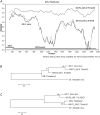Bovine noroviruses: A missing component of calf diarrhoea diagnosis
- PMID: 26631944
- PMCID: PMC7110452
- DOI: 10.1016/j.tvjl.2015.10.026
Bovine noroviruses: A missing component of calf diarrhoea diagnosis
Abstract
Noroviruses are RNA viruses that belong to the Genus Norovirus, Family Caliciviridae, and infect human beings and several animal species, including cattle. Bovine norovirus infections have been detected in cattle of a range of different ages throughout the world. Currently there is no suitable cell culture system for these viruses and information on their pathogenesis is limited. Molecular and serological tests have been developed, but are complicated by the high genetic and antigenic diversity of bovine noroviruses. Bovine noroviruses can be detected frequently in faecal samples of diarrhoeic calves, either alone or in association with other common enteric pathogens, suggesting a role for these viruses in the aetiology of calf enteritis.
Keywords: Bovine noroviruses; Diagnosis; Diarrhoea; Molecular epidemiology.
Copyright © 2015 Elsevier Ltd. All rights reserved.
Figures





Comment in
-
Untangling the complexity of diseases such as calf diarrhoea is crucial to future productivity.Vet J. 2016 Apr;210:3-4. doi: 10.1016/j.tvjl.2015.11.005. Epub 2015 Nov 17. Vet J. 2016. PMID: 26831166 Free PMC article. No abstract available.
Similar articles
-
First detection of bovine noroviruses and detection of bovine coronavirus in Australian dairy cattle.Aust Vet J. 2018 Jun;96(6):203-208. doi: 10.1111/avj.12695. Aust Vet J. 2018. PMID: 29878330 Free PMC article.
-
Identification of bovine enteric Caliciviruses (BEC) from cattle in Baden-Württemberg.Dtsch Tierarztl Wochenschr. 2007 Jan;114(1):12-5. Dtsch Tierarztl Wochenschr. 2007. PMID: 17252930
-
Molecular epidemiology of bovine noroviruses in South Korea.Vet Microbiol. 2007 Sep 20;124(1-2):125-33. doi: 10.1016/j.vetmic.2007.03.010. Epub 2007 Mar 28. Vet Microbiol. 2007. PMID: 17466472 Free PMC article.
-
Animal noroviruses.Vet J. 2008 Oct;178(1):32-45. doi: 10.1016/j.tvjl.2007.11.012. Epub 2008 Feb 21. Vet J. 2008. PMID: 18294883 Review.
-
Canine noroviruses.Vet Clin North Am Small Anim Pract. 2011 Nov;41(6):1171-81. doi: 10.1016/j.cvsm.2011.08.002. Vet Clin North Am Small Anim Pract. 2011. PMID: 22041209 Free PMC article. Review.
Cited by
-
Genetic diversity and epidemiology of Genogroup II noroviruses in children with acute sporadic gastroenteritis in Shanghai, China, 2012-2017.BMC Infect Dis. 2019 Aug 22;19(1):736. doi: 10.1186/s12879-019-4360-1. BMC Infect Dis. 2019. PMID: 31438883 Free PMC article.
-
Comprehensive Genomics Investigation of Neboviruses Reveals Distinct Codon Usage Patterns and Host Specificity.Microorganisms. 2024 Mar 29;12(4):696. doi: 10.3390/microorganisms12040696. Microorganisms. 2024. PMID: 38674640 Free PMC article.
-
Diagnosis and Treatment of Infectious Enteritis in Neonatal and Juvenile Ruminants.Vet Clin North Am Food Anim Pract. 2018 Mar;34(1):101-117. doi: 10.1016/j.cvfa.2017.08.001. Epub 2017 Dec 20. Vet Clin North Am Food Anim Pract. 2018. PMID: 29275032 Free PMC article. Review.
-
Genetic and phylogenetic analyses of the first GIII.2 bovine norovirus in China.BMC Vet Res. 2019 Sep 2;15(1):311. doi: 10.1186/s12917-019-2060-0. BMC Vet Res. 2019. PMID: 31477115 Free PMC article.
-
The first complete genome sequence and genetic evolution analysis of bovine norovirus in Xinjiang, China.J Vet Res. 2024 Mar 23;68(1):1-8. doi: 10.2478/jvetres-2024-0005. eCollection 2024 Mar. J Vet Res. 2024. PMID: 39224655 Free PMC article.
References
-
- Alcalà A.C., Hidalgo M.A., Obando C., Vizzi E., Liprandi F., Ludert J.E. Detección molecular de calicivirus entéricos de bovinos en Venezuela. Acta Cientifica Venezolana. 2003;54:148–152. - PubMed
Publication types
MeSH terms
LinkOut - more resources
Full Text Sources
Other Literature Sources
Medical

